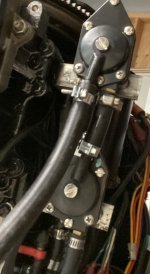I got this V-4 (E140TLERR) a month ago and I've been battling with it since. It bogs down like it shutting off under acceleration and sometimes while cruising. Usually above 3500rpm, but sometimes less. Even when it behaves, it just seems to be running without much power. Will only push my 17' Larson to 42(tried several props) while my 1983 115 Mariner could get it to 46. It still has the VRO system connected. Here is what I've done.
Tried portable fuel tank and line
ohmed the coils
checked spark air gap past 1/2"
indexed flywheel and put a timing light on it at 2000-2500 rpm(looks spot on)
It has a new impeller
Tested VRO alarms
I've done more, I just can't remember at the moment(will edit)
could it be shift switch, fuel pump, power pack???
I noticed a couple times it didn't want to start when hot without holding in the primer key. I believe the seller mentioned that they rebuilt the carbs. I just texted him to verify. Motor likely sat for a few years. I bought it from a guy who lived at a campground. No, he's not homeless. He bought the whole dang campground right by a creek off of the Clackamas River. It's an impressive spread. All the out-buildings were converted into garages/shops/toy storage. It's like straight out of my dreams. Only neighbor is Squatch. He has his own mechanic on payroll to keep his toys running. As far as seller's go, I felt pretty good about this one. But I only got to see it run on on a stand on muffs, so you never know unless it's on a boat on the water.
He has his own mechanic on payroll to keep his toys running. As far as seller's go, I felt pretty good about this one. But I only got to see it run on on a stand on muffs, so you never know unless it's on a boat on the water.
The VRO system seems to be functioning, but I'm wondering about the fuel pump. Any thoughts?
Tried portable fuel tank and line
ohmed the coils
checked spark air gap past 1/2"
indexed flywheel and put a timing light on it at 2000-2500 rpm(looks spot on)
It has a new impeller
Tested VRO alarms
I've done more, I just can't remember at the moment(will edit)
could it be shift switch, fuel pump, power pack???
I noticed a couple times it didn't want to start when hot without holding in the primer key. I believe the seller mentioned that they rebuilt the carbs. I just texted him to verify. Motor likely sat for a few years. I bought it from a guy who lived at a campground. No, he's not homeless. He bought the whole dang campground right by a creek off of the Clackamas River. It's an impressive spread. All the out-buildings were converted into garages/shops/toy storage. It's like straight out of my dreams. Only neighbor is Squatch.
The VRO system seems to be functioning, but I'm wondering about the fuel pump. Any thoughts?


